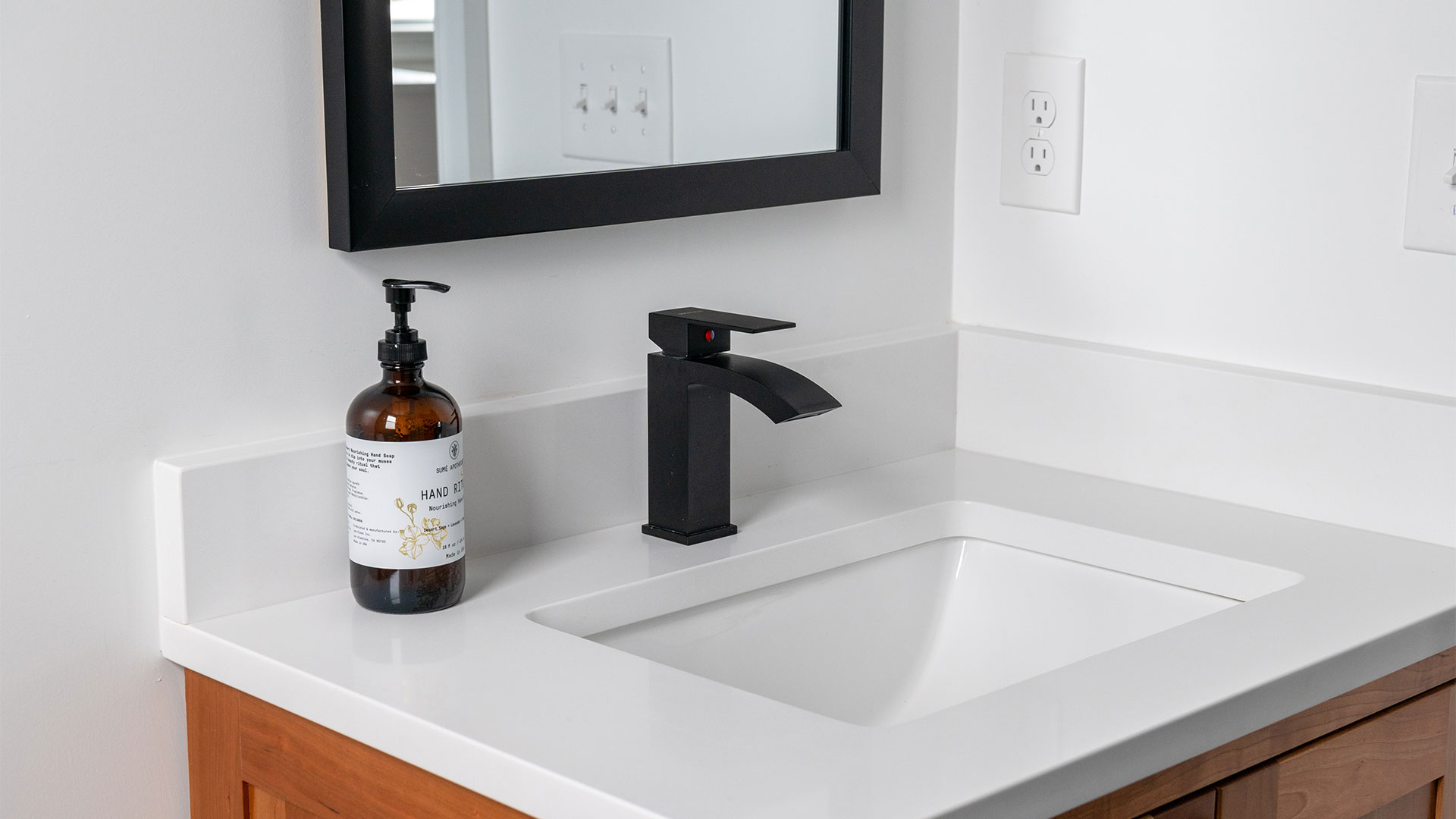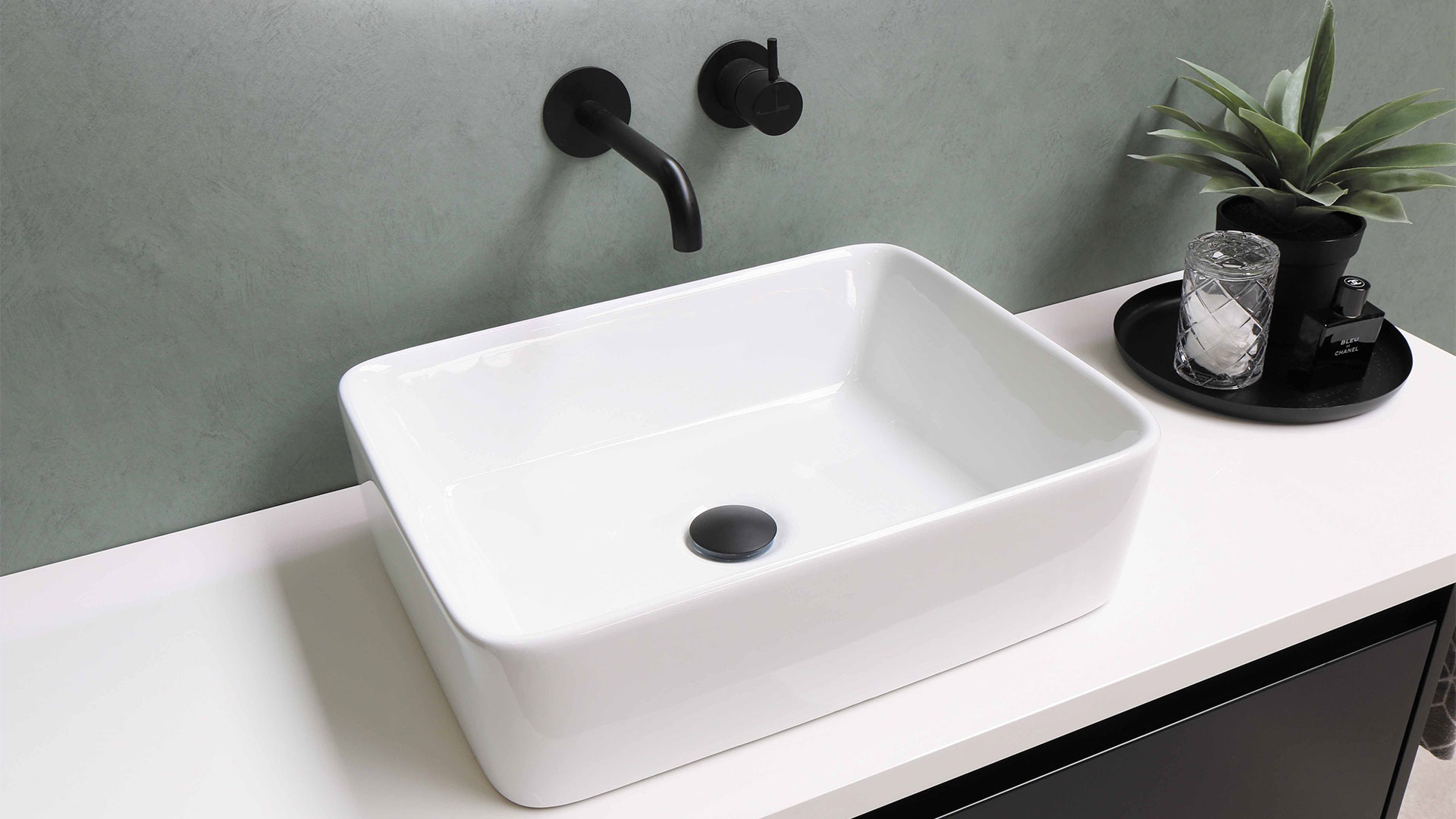How to Remove and Install a Bathroom Sink Faucet
Removing a bathroom sink faucet or replacing it with a new one is a common part of bathroom remodeling at almost any level. Along with other cosmetic fixes, installing a new bathroom faucet is an easy and quick way to make your bathroom noticeably nicer. Even though it's a modest DIY project, there are important considerations when installing a new bathroom faucet.
Things You'll Need:
- Adjustable wrench
- Tongue-and-groove pliers
- Basin wrench
- Putty knife
- New bathroom faucet
- Cloth
- Drain wrench

Step 1: Cut Off the Water Supply
Begin by shutting off the water supply to the sink. Normally, this will mean turning the handles on the inlet valves below the sink in a clockwise direction. If the faucet does not have fixture shutoff valves, then you will need to shut off the house's main water supply valve, which is usually located near your home's water meter.
After the water has been shut off, open the faucet to make sure the water is on longer on and also to release pressure in the water pipes.
Step 2: Disconnect the Water Supply pipes
Disconnect the flexible water supply pipes that run from the inlet valves to the threaded tailpieces on the faucet. Maybe the configuration of these pipes will vary, but the goal is to disconnect them entirely from the faucet and from the inlet valves. An adjustable wrench or will do this job easily by turning the chromed mounting nuts counterclockwise off the faucet tailpieces. If you have trouble reaching the faucet tailpieces, then a basin wrench may be required. While it's possible to reuse the old water supply tubes when replacing a bathroom faucet, it's generally better practice to install new pipes.
If on widespread faucets where the hot and cold water valves are set apart from the spout assembly, there may be additional short water supply pipes that link the hot and cold valves to the spout body. In this case, you will also need to unscrew those shorter supply tubes from both the valves and from the spout in order to extract them from the countertop.
Step 3: Disconnect the Pop-Up Drain Rod
Many faucets operate the pop-up stopper by means of a horizontal pivot rod that is raised and lowered with a vertical lift rod that slides through an opening on the body of the faucet. To disconnect, pinch the spring clip on the lift rod from below and behind the sink and then slide the lift rod off the pivot rod. Loosen the thumbscrew that holds the clevis strap from the lift rod and then extract the lift rod up and out of the faucet body.
Step 4: Remove the Faucet Mounting Nuts
From below the sink, remove the mounting nuts that hold the faucet body to the sink or the countertop. This can be the hardest part of the process since these nuts can be corroded and frozen onto the faucet tailpieces. Use a basin wrench to reach up behind the basin from below and grasp onto the mounting nuts threaded onto the faucet tailpieces. Attempt to loosen the nuts by turning them counterclockwise. Once the nuts are loosened, screw them completely off the faucet tailpieces.
The exact means for securing the faucet to the sink can vary depending on the style of faucet. Sometimes, there is a threaded mounting ring that is secured to the faucet tailpiece with a setscrew. This setscrew may need to be loosened in order to unscrew the mounting ring.
Step 5: Remove the Faucet and Clean the Sink
Remove the faucet body away from the sink or countertop using a putty knife. On widespread faucets, you will need to remove both the spout unit and the two water valves. Once the faucet body has been extracted from the opening, carefully clean off any plumbers' putty around the opening in the sink or countertop using a putty knife and cloth.

Step 6: Remove the Drain Assembly
If you are replacing the drain assembly, start by disconnecting the drain trap from the drain tailpiece on the sink using tongue-and-groove pliers. Next, grip the drain assembly with a drain wrench inserted into the drain opening from inside the sink. The prongs on the drain wrench will hold the drain assembly in place as you loosen the mounting nut.
From below the sink, use tongue-and-groove pliers to loosen the mounting nut that is threaded onto the drain tailpiece. With the mounting nut removed, the entire drain tailpiece can be lifted out of the sink. Clean away any old plumbers' putty from around the drain opening using a putty knife and cloth.
Step 7: Attach the New Drain Assembly
If you are replacing a new drain assembly, follow the manufacturer's directions for inserting the drain unit through the sink drain opening and securing it in place. The drain unit may require lining the edge of the drain opening with a bead of plumbers' putty, but other drain units make use of a rubber or fiber seal to make this joint watertight. Thread the mounting nut onto the tailpiece of the drain unit from below the sink.
Hold the drain assembly steady with a drain wrench inserted down inside the drain from above and then tighten the mounting nut onto the drain tailpiece from below using tongue-and-groove pliers. Some drain units are plastic, so be careful to not overtighten the mounting nut. Make sure the drain assembly is aligned so that the threaded opening for the pop-up stopper's pivot rod is pointed backward. With the drain unit secured, reconnect the drain trap to the drain tailpiece.
Step 8: Mount the New Faucet
Prepare the opening for the new faucet body as directed by the manufacturer. This may mean placing a bead of plumbers' putty or silicone caulk around the base of the faucet, or it may mean placing a rubber gasket around the opening to create the seal between the faucet body and the sink or countertop. Insert the faucet tailpieces into the openings on the sink or countertop and align the faucet so it is straight.
Loosely thread the mounting nuts onto the faucet tailpieces from below the sink. Make sure the faucet is correctly aligned and then tighten down the mounting nuts securely using a basin wrench.
Step 9: Attach the Pop-Up Drain Lever
Following manufacturer directions, attach the pop-up drain rod and lever to the drain unit. In most cases, this involves sliding the lift rod down through an opening on the faucet body, inserting the pivot lever into the drain tailpiece and then linking the vertical drain rod to the horizontal pivot rod using a clevis strap secured with a thumbscrew. Some experimentation and adjustment may be needed to get the pop-up stopper to operate smoothly.
Step 10: Attach Water Supply Tubes
Attach the flexible water supply tubes from the shutoff valves to the faucet valves. (With some faucets, the supply tubes are part of the faucet kit; with others, you will need to buy the supply tubes separately.) The mounting nuts on the supply tubes are usually easy to connect to the shutoff valves and to the faucet tailpieces with an adjustable wrench. Make sure the hot and cold shutoff valves are joined to the corresponding valves on the faucet — hot to hot, cold to cold.
If you are installing a widespread faucet, also attach the short supply tubes that run from the hot and cold valves to the spout body.
With the supply tubes tightened hand-tight, give each mounting nut an additional 1/4 turn with an adjustable wrench (or with a basin wrench if it's hard to reach the nuts with a standard wrench).
Step 11: Test the Faucet
Turn on each fixture inlet valve and operate the faucet to make sure it works correctly. Some air may rush through the faucet until water begins to flow. Examine all water supply and drain connections for signs of leaking. if necessary, tighten the connections a bit more to stop leaks.




